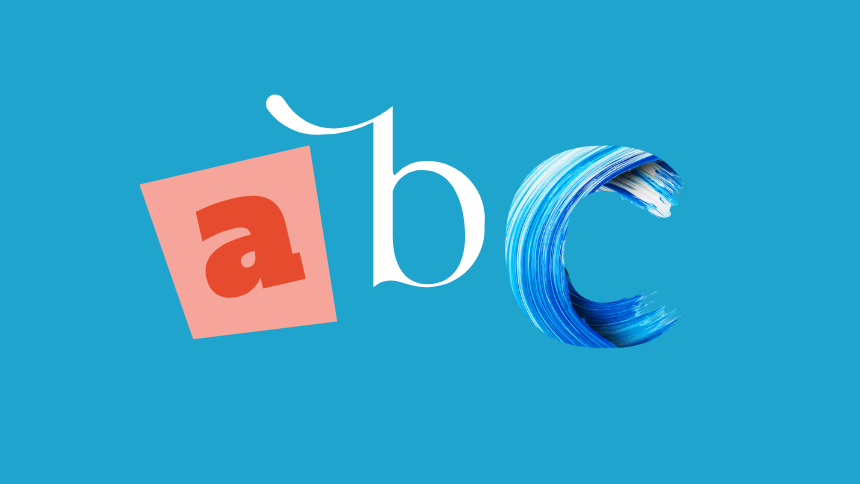Mastering the art of typography
Typography plays a crucial role in shaping a brand’s identity and communicating its personality to the audience. Selecting the perfect typeface requires careful consideration, as it can influence how your brand is perceived. In this article, we will explore techniques to help you navigate the vast world of typography and choose the ideal font for your brand.
- Understand your brand personality: before delving into the world of fonts, it’s essential to have a clear understanding of your brand’s personality and values. Are you aiming for a modern, sophisticated look, or does your brand exude a more playful and informal vibe? Aligning your typography with your brand’s personality is the first step in creating a cohesive visual identity.
- Consider readability and legibility: the readability of your text is paramount. Choose a font that is easy to read across various platforms and sizes. Consider the legibility of both body text and headlines, ensuring that your audience can effortlessly absorb your brand message without strain.
- Know your font categories: familiarize yourself with different font categories, such as serif, sans-serif, script, and display fonts. Each category has its own characteristics and evokes specific emotions. For instance, serif fonts often convey tradition and reliability, while sans-serif fonts are associated with modernity and simplicity.
- Think about versatility: opt for a font that is versatile and suitable for various applications. A typeface that works well in both digital and print formats ensures consistency across different mediums. Consider how the font will appear in various sizes and weights to maintain coherence in your brand visuals.
- Pair fonts thoughtfully: if your brand requires multiple typefaces, ensure they complement each other harmoniously. Choose fonts that create a balanced and visually appealing combination. Pairing a bold, attention-grabbing headline font with a more neutral, easy-to-read body font is a common strategy.
- Test for accessibility: accessibility is a crucial consideration in today’s digital landscape. Ensure that your chosen typeface meets accessibility standards, offering clarity and easy legibility for individuals with visual impairments. Check color contrast and font size to enhance accessibility across diverse audiences.
- Stay consistent across brand elements: consistency is key to building a strong and recognizable brand. Once you’ve chosen your typography, maintain consistency across all brand elements, including your website, marketing materials, and social media platforms. This uniformity reinforces your brand identity in the minds of your audience.
- Explore custom typography: For a truly unique and distinctive brand identity, consider investing in custom typography. Tailoring a font to align perfectly with your brand can set you apart from competitors and reinforce brand recognition.
Choosing the perfect typography for your brand is a nuanced process that requires a thoughtful blend of aesthetics, functionality, and brand personality. By understanding your brand, considering readability, exploring font categories, and staying consistent, you can make informed decisions that contribute to a strong and memorable visual identity. Mastering the art of typography is a powerful tool in creating a lasting and positive impression on your audience.
The Do's and Don'ts of branding
Building a strong brand takes time, effort, and careful planning. As a small business owner, it’s important to approach branding strategically and avoid common mistakes that can undermine your efforts. Here are a few do’s and don’ts to keep in mind when building your brand:
Do:
1. Define your unique value proposition: use it to guide your messaging and marketing efforts.
2. Invest in high-quality visual branding: this includes a well-designed logo, color scheme, and typography.
3. Prioritize consistency: ensure that all aspects of your branding, from messaging to visual identity, remain cohesive.
Don’t:
1. Try to please everyone: focus on your target audience and craft messages that directly address their needs.
2. Neglect your online presence: in today’s digital age, your website and social media accounts often form the first impression you make on potential customers.
3. Be afraid to evolve: don’t hesitate to adapt your branding over time. It should evolve in tandem with the growth and changes in your business.
At our digital marketing agency, we specialize in helping small businesses develop and execute effective branding strategies. Contact us today to learn how we can help you build a brand that drives real results for your business.
Join the #NectarCollective community
#NectarCollective is more than just a hashtag; it’s a community of businesses committed to thriving in the digital age. Share your progress, insights, and success stories on social media, and let’s build a collective narrative of growth and achievement.
Decoding the Key Components of a Strong Brand Identity
In the digital realm, user experience (UX) and user interface (UI) design play a pivotal role in capturing and retaining users’ attention. Nectar understands the significance of UI/UX design and is here to shed light on its impact.
User-Centric Approach:
Design with the user in mind, prioritizing their needs and preferences.
Intuitive Navigation:
Create a seamless and intuitive flow that guides users through your website, social media or app.
Visual Consistency:
Maintain a consistent design language to create a cohesive and engaging experience.
Responsiveness:
Ensure your design is optimized for various devices and screen sizes.
Usability Testing:
Regularly test your design with real users to identify and address any pain points.
Ready to enhance your digital platforms with exceptional UI/UX design? Nectar can help you create user-friendly and visually appealing interfaces that leave a lasting impression. Contact us today to elevate your digital experience!
The Blueprint for a Consistently Powerful Brand Identity
Establishing a strong and consistent brand identity is key to building trust, recognition, and loyalty among your audience. A digital brand guidelines book serves as a comprehensive reference that outlines your brand’s visual and tonal guidelines, ensuring consistency across all marketing channels.
Define Your Brand’s Visual Identity
Start by defining your brand’s visual elements, including logo usage, typography, color palette, and imagery guidelines. Clearly communicate how these elements should be used across different mediums to maintain a cohesive brand image.
Establish Tonal Guidelines
Define your brand’s voice and tone to ensure consistent messaging across all communication channels. Outline guidelines for writing style, vocabulary, and tone of voice to reflect your brand’s personality and values consistently.
Provide Design Templates and Examples
Include design templates and examples within your digital brand guidelines book to guide designers and content creators. These templates can help maintain consistency in marketing collateral, social media posts, website layouts, and other visual assets.
Outline Usage Guidelines for Digital Platforms
Specify how your brand should be represented on various digital platforms such as social media, email marketing, and websites. Provide guidelines for profile pictures, cover photos, social media post layouts, and email templates to ensure consistent branding and a seamless customer experience.
Update and Distribute the Guidelines
Regularly review and update your digital brand guidelines book to reflect any changes in your brand strategy or visual identity. Make the guidelines easily accessible to your team members and stakeholders so they can refer to them consistently.
Let’s craft a digital brand guidelines book that serves as a blueprint for your brand’s success and witness the transformative impact on your brand identity.
From Groovy to Lit: The Evolution of Slang Words Across Generations
Slang words are a staple in modern language, but they are constantly evolving, especially across different generations. What was once considered cool and hip in the past is now outdated and even cringe-worthy. In this article, we’ll take a closer look at how slang words have evolved across generations and how brands can integrate them into their marketing strategies.
Slang Words Across Generations
Each generation has its own unique set of slang words that reflect its culture and experiences. For example, baby boomers used phrases like “groovy” and “far out” in the 1960s and 1970s, while Generation X popularized words like “rad” and “totally” in the 1980s and 1990s. Millennials, on the other hand, introduced words like “lit” and “on fleek” in the 2010s, while Gen Z has popularized terms like “stan” and “cancel” in recent years.
Brands that understand and integrate the latest slang words into their marketing strategies connect with their target audience in a more meaningful and authentic way.
Integrating Slang Words into Marketing Strategies
When it comes to integrating slang words into marketing strategies, it’s important to consider the target audience. For example, if a brand is targeting baby boomers, using phrases like “groovy” and “far out” may resonate with them. However, if a brand is targeting Gen Z, using terms like “dank” and “glow up” may be more effective.
Integration tips:
- Understand the target audience and the slang words they use.
- Use slang words in a natural and authentic way. Forced or awkward usage can backfire and make the brand seem out of touch.
- Stay up-to-date on the latest slang words and trends. Slang words are constantly evolving, so it’s important to stay current.
- Avoid using slang words that may be offensive or insensitive. Some slang words have negative connotations, so it’s important to be aware of their meanings and contexts.
- Test and measure the effectiveness of using slang words in marketing campaigns. This will help brands determine which words resonate with their target audience and which ones don’t.
Slang words are a dynamic aspect of language that evolves with each generation. Brands that understand and integrate the latest slang words into their marketing strategies can connect with their target audience in a more meaningful and authentic way.
The Future of Branding in a Digital World
The future of branding is becoming increasingly digital. Here are a few trends and predictions for what’s next in the world of digital branding:
1. Personalization:
As consumers become more accustomed to personalized experiences, brands will need to find new and innovative ways to tailor their messaging and offerings to individual customers.
2. Augmented Reality:
With the rise of AR technology, brands will have new opportunities to create immersive and interactive experiences that blur the lines between the physical and digital worlds.
3. Voice Search:
As more consumers rely on voice assistants like Siri and Alexa, brands will need to optimize their content and messaging for voice search queries.
4. Artificial Intelligence:
As AI technology continues to advance, brands will be able to leverage data and analytics to deliver highly targeted and personalized messaging and experiences to customers.
At our digital marketing agency, we stay on the cutting edge of emerging trends and technologies in digital branding. If you’re looking to future-proof your branding strategy and stay ahead of the curve, contact us today to learn how we can help.
Let us help you build a brand that’s ready for whatever the future holds.
Branding your business to success.
Branding is a crucial element for your businesses, as it helps to establish a unique identity and reputation in the market. It is the process of creating an image and perception of your company that sets it apart from competitors. In this article, we will discuss the essential elements of branding and how they can help your organization achieve your goals.
- Target audience: Understanding your target audience’s needs and desires is essential for creating a brand identity that resonates with them. You should tailor your brand’s messaging and image to meet the needs of your target audience.
- Logo: A well-designed logo is a symbol that represents your brand and helps to establish your identity. It should be distinctive, memorable, and easily recognizable.
- Messaging: Consistent messaging is vital for creating a brand identity that resonates with your target audience. It should reflect the values and personality of your brand and be consistent across all platforms.
- Social media: Social media is an essential tool for branding as it allows you to connect with your customers in real-time. Your brands can use social media platforms to showcase products and services and engage with your audience.
- Long-term investment: Branding is not a one-time event, but a continuous process. As your business evolves, your branding should also evolve to reflect these changes. Consistency and staying true to your core values are key to building a lasting brand.
Branding is an integral part of any successful business. It is a process of creating a unique identity and reputation that resonates with your target audience. Let’s build credibility, trust, and loyalty with your customers.






